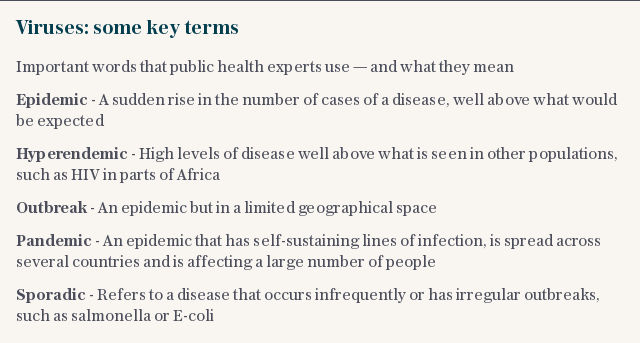Coronavirus outbreak: What is a pandemic and what happens if one is declared?

With more and more cases emerging in Europe – and a rapid rise in infections in South Korea and the Middle East – some virologists are warning that the coronavirus, or Covid-19, is now at "pandemic" stage.
But what does this mean and what are the implications?
What is a pandemic?
A pandemic, a word from the Greek pan ("all") and demos ("people"), is the term used by disease experts when epidemics are growing in multiple countries and continents at the same time.
Despite the fear the word evokes, "pandemic" refers to the spread of a disease, not its potency or deadliness.
The World Health Organisation defines the term as "an outbreak of a new pathogen that spreads easily from person to person across the globe".

This means a disease outbreak will only be called a pandemic when it is widespread, over several countries or continents, and usually affecting a large number of people. The disease must also be infectious – cancer affects many people around the world, but it is not infectious and so is not a pandemic.
A pandemic also has self-sustaining lines of infection – so if there is an increasing number of cases in Europe and the United States with no clear connection to China, that will fit the definition of a pandemic.
What’s the difference between a pandemic and an epidemic?
An epidemic refers to an event in which a disease is actively spreading. Usually, this is an outbreak that has grown out of control but is often within one country or location.
A pandemic is an epidemic on a far greater geographic scale that affects a much large number of people.
So is the coronavirus a pandemic?
Given that the virus has now spread to over 30 countries and across multiple continents, many experts believe the situation satisfies the WHO’s definition of a pandemic. But the UN agency has repeatedly insisted that we are "not there yet", suggesting we are instead fighting a series of epidemics.
"For the moment, we are not witnessing the uncontained global spread of this virus and we are not witnessing large-scale severe disease or deaths," Dr Tedros Adhanom Ghebreyesus, the WHO director general, said.
"Does this virus have pandemic potential? Absolutely it has. Are we there yet from our assessment? Not yet."

He added: "I have spoken consistently about the need for facts not fear, using the world pandemic now does not fit the facts but may certainly cause fear."
On January 30, the WHO declared the outbreak to be a public health emergency, the highest level classification to describe a disease outbreak under the International Health Regulations.
What happens if the WHO declares a pandemic?
When the WHO declared a pandemic for the H1N1 influenza outbreak in 2009, the decision was criticised by some countries, which felt that caused unnecessary panic. It also led to many countries wasting money on vaccines for a strain of flu that proved to be mild and relatively easy to contain.
But a lot has changed since 2009, and the WHO says there is no longer a formal process to categorise an outbreak as a pandemic.
A spokesperson told The Telegraph: "WHO does not use the old system of six phases – that ranged from phase one (no reports of animal influenza causing human infections) to phase six (a pandemic) – that some people may be familiar with from H1N1 in 2009. We do use term pandemic for all sorts of purposes and may qualify a situation as pandemic, but there would no official announcement."
But even though though it is not an official process, if the WHO uses the term that could still have serious consequences.
According to WHO's pandemic preparedness plan, a response to a pandemic would require national governments to action the "full mobilisation of health systems, facilities, and workers at national and subnational levels", to "distribute personal protective equipment" and to "distribute antivirals and other medical supplies in accordance with national plans".
The Centers for Disease Control and Prevention (CDC), the body responsible for public health in the United States, is already preparing for a pandemic.
What's the economic impact of a pandemic?
According to the World Bank, the annual global cost of moderate to severe pandemics is about $570 billion (about £440 billion) or 0.7 per cent of the world's income.
The Sars outbreak in 2002-03 – which only infected about 8,000 people – caused about $50 billion in damage to the global economy. Although its mortality rate is lower, the coronavirus could be even more destructive. This is partly because of the world’s greater reliance on China than 17 years ago. China represented just five per cent of the world economy during Sars – now it accounts for a fifth, and about a third of global growth.
In addition, China’s economy could be more vulnerable now because of the growth of its service sector.
Microsoft founder and philanthropist Bill Gates has also suggested that a pandemic could overwhelm global health systems and kill 10 million Africans.
Writing in The Telegraph, Tom Stevenson said we are already moving into phase two of the markets’ response to viruses. After phase one, looking at the pattern of previous outbreaks and hoping it all blows over, is the "spreadsheet and profit warning" phase.
"This is when the authorities focus on policy measures to get businesses back on their feet and companies begin managing their investors’ expectations," he said.
Fears over the potential economic impact could be one of the reasons why WHO has not yet called the escalating situation a pandemic.
What's an example of a pandemic?
Pandemics can vary greatly in scale and potency, but examples include HIV, swine flu and the 1918 Spanish flu.
Some of the most deadly pandemics in history were the Black Death, which killed up to 200 million people in the Middle Ages, and smallpox, which killed about 300 million in the 20th century.

How do you stop a pandemic?
Preventing the spread of a disease varies depending on a number of factors including its virulence, healthcare provision and being able to detect the spread.
The coronavirus can be spread by carriers who have minimal or no symptoms, making it harder to track and contain. For example, among the passengers from the Diamond Princess cruise ship who have tested positive for the virus about half had no obvious symptoms.
Some patients have fallen ill from the virus long after they were exposed. This raises questions about the virus's incubation period which is currently thought to be around 14 days, an assumption that is the basis of many quarantine procedures.

Protect yourself and your family by learning more about Global Health Security. And sign up to our weekly newsletter here.

 Yahoo News
Yahoo News 